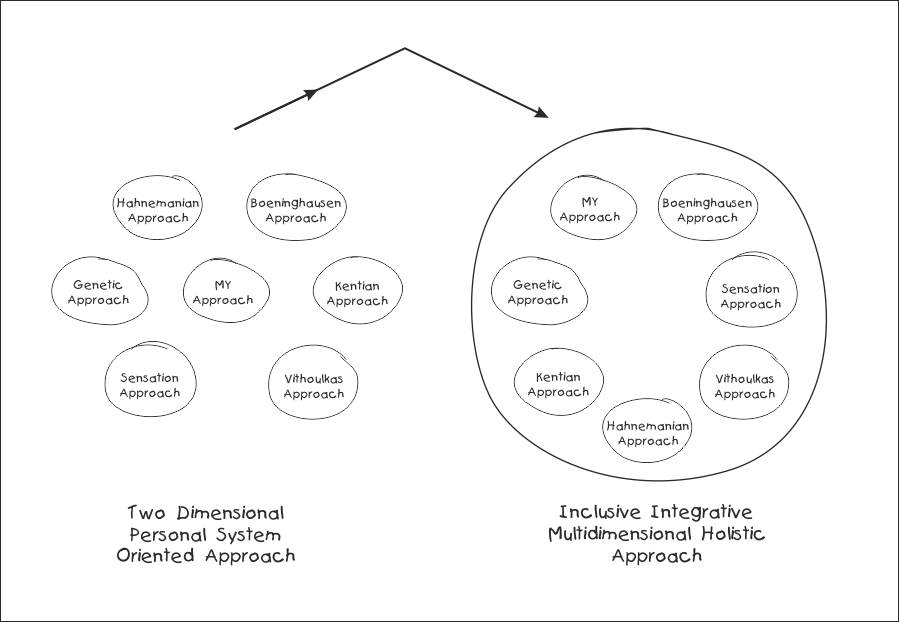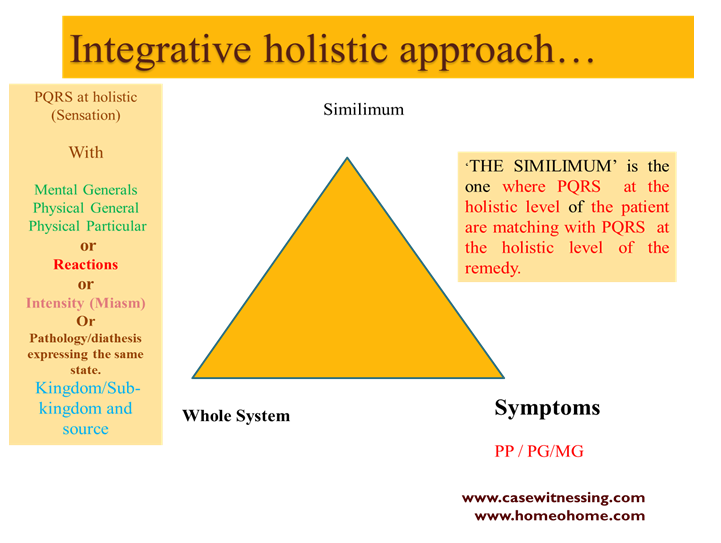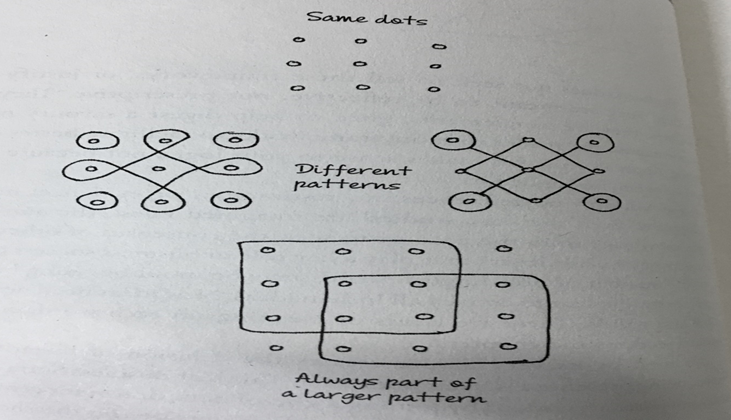A journey into the homoeopathic enquiry should be an all-inclusive one, the one that is based on the homoeopathic principles of Holism, Individualisation and Similimum.

I would like to share with you all a story which has touched me recently…it is about Lord Vishnu, his ardent devotee Narada and Garuda…the story goes…
One day, Narada asked Vishnu, “Why do you insist that the image of Garuda be placed before you in your temples? Why not me? Am I not your greatest devotee?”
Before Vishnu could reply a crash was heard outside the main gate of Vaikuntha. “What was that?” asked Vishnu. Narad turned to look in the direction of the sound. “I have sent Garud on an errand. Can you find out what happened, Narad?” asked Vishnu.
Eager to please Vishnu, Narad ran out to investigate. “A milkmaid tripped and fell,” he said when he returned.
“What was her name?” asked Vishnu. Narad ran out, spoke to the maid and returned with the answer. “Sharada,” he said.
“Where was she going?” asked Vishnu. Narad ran out once again, spoke to the maid and returned with the answer. “She was on her way to the market.”
“What caused her to trip?” asked Vishnu. “Why did you not ask this question the last time I went?” said Narad irritably. He then ran out, spoke to the maid once again. “She was startled by a serpent that crossed her path,” he said on his return.
“Is the pot she was carrying broken?” asked Vishnu. “I don’t know,” snapped Narad. “Find out,” said Vishnu. “Why?” asked Narad. “Find out, Narad. Maybe I would like to buy some milk,” said Vishnu.
With great reluctance, Narad stepped out of Vaikuntha and met the milkmaid. He returned looking rather pleased, “She broke one pot. But there is another one intact. And she is willing to sell the milk but at double price.”
“So how much should I pay her?” asked Vishnu. “Oh, I forgot to ask. I am so sorry,” said Narad running out once again. “Do not bother. Let me send someone else,” said Vishnu.
Just then, Garud flew in. He had no idea of what had transpired between Vishnu and Narad. Vishnu told Garud, “I heard a crashing sound outside the main gate. Can you find out what happened?” As Garud left, Vishnu winked at Narad and whispered, “Let us see how he fares.”
Garud returned after 10-15 minutes. “It is a milkmaid called Sharada. She was on her way to the market. On the way, a snake crossed her path. Startled, she fell back and broke one of the two pots of milk she was carrying. Now she wonders how she will make enough money to pay for the broken pot and the spilt milk. I suggested she sell the milk to you. After all, you are married to Lakshmi, the goddess of wealth.” “And the price of the milk?” asked Vishnu. Pat came Garud’s reply, “Four copper coins. One actually but I think she hopes to make a handsome profit when dealing with God.” Vishnu started to laugh.
His eye caught Narad’s and Narad understood at that instant why Garud’s statue and not his is always placed before the image of Vishnu in Vishnu temples.
So there is one way into the journey of inquiry that is the Narada Approach and the other is the Garuda approach, which one do you think has more depth and meaning?
The Garuda approach is where one gets a bird’s eye view of the entire problem at the whole level. A journey into the homoeopathic enquiry should thus be just like the “Garuda” an all-inclusive one, the one that is based on the homoeopathic principles of Holism, Individualisation and Similimum.
I have always believed that a holistic all inclusive integration in all aspects of homoeopathy will take the homoeopathic art and science to its peak…
Be it in the case witnessing process, be it in giving advice to the patient, be it in follow ups, potency, be it analysing to prescribing the remedy, in understanding the materia medica, in utilising the repertory, in dealing with different types of cases, a holistic integration is a the pivotal key in the homoeopathic journey.
If we have an holistic understanding of the materia medica, repertory, of different schools of homoeopathy, of medicines in their natural form, as well as of the patient, then applying the similia principle becomes effortless, matching the holistic centre of the patient with the holistic centre of the remedy becomes effortless, then the homoeopathic science with all its different approaches becomes all inclusive, under the one tree of the integration and holism…
With my experiences if I had to share one gem with you it would be the Garuda approach, if you believe in obtaining a bird’s eye view then an all-inclusive connected effortless holistic integration will happen individually and universally…
Let me take you further…
We know that in every individual case the journey starts with a mixed bag of symptoms, it’s a mixture of common and peculiar symptoms. From all these symptoms we need to pick up the most peculiar characteristic symptoms of the patient which will help us to understand the individuality of the patient. Slowly as we go deeper in the case, from the mental general, physical general and physical particular symptoms, come up those symptoms which are common at the mind and body level that is the peculiar symptoms at the holistic level, these are the most individualising symptoms, which will take us to the remedy.
This is the PQRS at the holistic level, the most individualistic expression (sensation) which comes up during the Active-active case witnessing process, this expression is the centre of the individual.
As the case unfolds slowly the system also unfolds for us. Which means that during the case along with the PQRS at the holistic level we will get additionally a clue which will define which system would we use to find a remedy in that particular patient.
For example if we get PQRS at holistic level, and in addition we get a very peculiar mental general or physical general or physical particular symptom then our system for coming to a remedy would be such that where we see the remedy covering the PQRS at holistic level and these symptoms, hence our method to find the remedy would be through the book we would use would be one where such keynote symptoms are given.
On the other hand if we have a very peculiar rubric coming along with the PQRS at the holistic level our system would use the appropriate repertory to find the remedy.
If in our case the PQRS at the holistic level gives us a definite theme of kingdom, subkingdom, source then we would use the Sankaran’s system to find out the remedy in the case. But if the PQRS whole came with a theme then the use of thematic materia medica through the remedy would define the search of the remedy. Hence as the case unfolds, the system unfolds, the similimum is the one which matches with this PQRS at the holistic level of the patient with the PQRS at the holistic level of the remedy.
Hence according to what the patient puts in the centre our approach will be defined, for this we cannot have a one or a two dimensional approach, our approach has to be patient centric, yes a multidimensional one…
Therefore our approach should be on that is all inclusive and multidimensional one…

Therefore our approach is a multidimensional approach depending on the individuals system which evolves during the case taking.
Multi-dimensional l Holistic approach…
- Whole (Sensation) (PQRS at holistic Level) + PQRS at PP/PG/MG Level
- Whole (Sensation) (PQRS at holistic Level) + Disease(Diagnosis) (Sphere of action)
- Whole (Sensation) (PQRS at holistic Level) + Diathesis (temperament).
- Whole (Sensation) (PQRS at holistic Level) + Miasm
- Whole (Sensation) (PQRS at holistic Level) + Themes (Thematic Materia Medica)
- Whole (Sensation) (PQRS at holistic Level) + Kingdom/subkingdom/source)
- Whole (Sensation) (PQRS at holistic Level) + Peculiar Rubric
- Whole (Sensation) (PQRS at holistic Level) + Mythology
This 9 dots is usually used as a pattern in drawing Rangoli outside many homes … if you see that the possibilities of forming a design from these 9 dots are many… the same 9 dots can be used differently like represented in the drawing below.

The integrative holistic multidimensional approach in Homoeopathy will bring about a true amalgamation of the old and the new, weaving all the beads into a single homoeopathic necklace…


